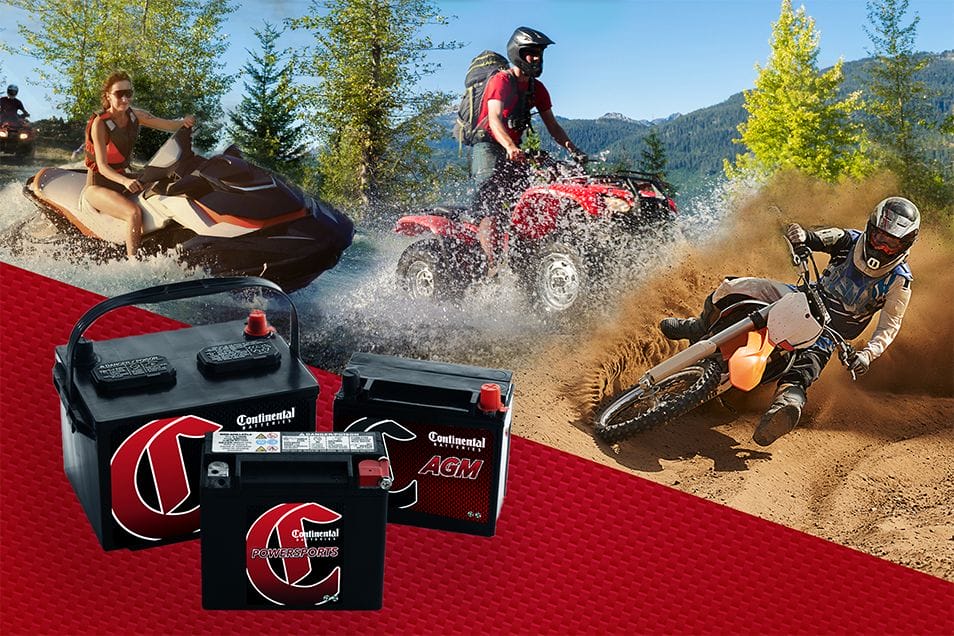
Welcome to your ultimate guide to powersport batteries. Summer is winding down, and whether you’re hitting the road on your motorcycle, off-roading on ATV adventures or getting in the last waves of the season on your jet ski, this guide is for you.
In this guide, we will cover everything you need to know about powersport batteries, including:
- Types of powersport batteries
- How to choose the right powersport battery for your vehicle
- Benefits of high-quality powersport batteries
- Tips for maintaining your powersport battery
What Are Powersport Batteries?
Powersport batteries are specialized batteries used in powersport equipment, such as ATVs, UTVs, personal watercraft, motorcycles and snowmobiles. They provide a high surge of power to start the engine and a steady supply of energy to keep your vehicle moving. Because powersports often involve rough terrain in extreme climates, powersport batteries also need to withstand vibration, heat and cold.
Anatomy of a Powersport Battery
Team Mayer Parts.de
Types of Powersport Batteries
The most common types of batteries found in powersport equipment are flooded lead-acid (FLA), absorbed glass mat (AGM) and lithium. Each type has unique benefits and disadvantages.
Flooded Batteries. Also known as wet cell batteries, flooded batteries are the most traditional type of powersport batteries. They contain electrolyte fluids that need regular maintenance and topping up. These batteries are affordable and provide reliable performance, but they must be kept upright to prevent spills. They are more susceptible to vibration damage, making them less ideal for rough terrains.
Absorbed glass mat (AGM). AGM batteries represent a more advanced technology compared to flooded batteries. They are sealed and maintenance-free, with the electrolytes absorbed into a fiberglass mat. AGM batteries are highly resistant to vibrations, have a longer lifespan and offer superior starting power. This makes them an excellent choice for powersport applications that demand durability and reliability.
Lithium. Lithium batteries use lithium-based chemistry in their cells. They are lightweight, have a higher energy density and offer fast recharging. While lithium batteries are more expensive upfront, their long-term benefits include low self-discharge rates and a much longer lifecycle. These batteries are ideal for those looking for top-tier performance and efficiency, especially in high-performance vehicles.
Choosing the Right Powersport Battery for Your Vehicle
The specific type of battery you choose depends on your vehicle and the manufacturer's specifications. But whether you’re hitting the waves or an off-road trail, there are a few key considerations to keep in mind when choosing the best powersport battery for your vehicle.
Compatibility. Ensure the battery is compatible with your vehicle's year, make and model. To do this, start by consulting with the owners manual or manufacturer. You can also seek advice from a Continental Battery Systems retailer, who can make sure you get the right fit.
Power. Check the battery’s power output, especially its cold-cranking amp (CCA) and amp-hour (AH) ratings. CCA measures the amount of power supplied by your battery when starting your vehicle on a really cold day (0 degrees Fahrenheit). It tells you how well your battery will perform in cold conditions. AH is a measure of much energy your battery can store. Matching these ratings to your vehicle specs helps ensure you won’t run out of power when you need it most.
Durability. The battery should be resilient enough to withstand the conditions in which you will use it. For particularly rough-and-tumble jobs, you may even consider an aftermarket battery box specially designed to keep the battery in place and protected.
Quality. Cost may be one factor in your decision, but in order to get the most life — and fun — out of your battery, opt for a reputable brand that offers a solid warranty.
How to Maintain Your Powersport Battery
Maintenance requirements vary by the type of battery. Traditional flooded lead-acid batteries require occasional topping off with distilled water. AGM batteries are maintenance-free but should be kept fully charged when not in use. Lithium batteries also require minimal maintenance but should not be over-discharged. Use the following battery maintenance tips to get the most out of your powersport battery.
Keep them clean. Batteries, especially flooded, can get corroded over time. If you spot corrosion, clean using a mixture of baking soda and water. If your jet ski battery is exposed to saltwater, make sure you rinse it clean after each use.
Charge properly. Keeping your battery fully charged will extend its lifespan. Keeping your battery charged will also prevent sulfation, which can happen in batteries that are regularly allowed to fully discharge. Be sure to select a charger that is compatible with your battery type. Opt for a smart or trickle charger to prevent overcharging.
Inspect regularly. The best way to extend the life of your powersport battery is to keep a close eye on it. Check the battery at least once a month for signs of corrosion, low electrolyte levels or other damage, like bulging or cracking.
Tips for Storing Powersport Batteries
Powersport equipment is often used seasonally, that means it’s likely your jet ski, ATV or motorcycle could be sitting in storage for extended periods of time. Follow these storage tips to ensure your battery is ready to roll when the season comes back around.
- Disconnect your battery from the vehicle and store it separately in a climate-controlled location.
- Fully charge your battery before storing.
- Your battery will lose charge while in storage. When it reaches a 70% state of charge, give it a boost charge. If you don’t want to monitor every four to six weeks, use a battery tender that will automatically charge your battery when the voltage drops.
- Keep your battery off the floor and away from direct heat sources.
Choose the Right Powersport Battery for Your Climate
Powersport vehicles are used to extremes, and that includes weather. Snowmobiles can zip through subzero temperatures, and personal watercraft jump waves in the hot sun. Both extremes can take a toll on your battery. Here’s how to choose the right power source for your climate.
For cold climates. Choose a battery with the highest cold cranking amp (CCA) available. CCA is the amount of power supplied by your battery when starting your vehicle on a really cold day. Always protect your battery from freezing by storing it in a climate-controlled area and covering it when not in use.
Lithium does not perform optimally in consistently sub-freezing temperatures. If you choose a lithium battery in such conditions, be sure it has a heater function built in.
For warm climates. Heat can drain a battery, leading to a faster discharge. If you spend a lot of time in warmer climates, opt for a higher reserve capacity. With a higher reserve capacity, a battery can maintain its charge longer — especially on very hot days.
How Long Does a Powersport Battery Last?
Even with proper storage and maintenance, eventually you’ll need to replace your powersport battery. FLA batteries, with regular use, generally last two to three years. AGMs can last up to five years. Lithium batteries have the longest lifespan and can run up to 10 years.
Replacing Your Powersport Battery
High-quality batteries have fewer issues and last longer. When it’s time to swap out your battery, bring it to your nearest Continental Battery Systems retailer to find the best battery designed for powersport applications. We’ll also collect your spent battery for recycling.








